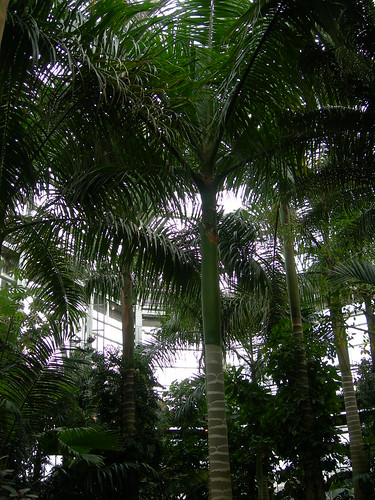 When I worked on the Mall, the Conservatory of the US Botanic Garden was a key part of my winter survival strategy. If you need a fix of green growing things, or of warm, steamy air, this is your place.
When I worked on the Mall, the Conservatory of the US Botanic Garden was a key part of my winter survival strategy. If you need a fix of green growing things, or of warm, steamy air, this is your place.At any given time, there are about 4,000 plants on display in these Botanic Garden greenhouses. A major highlight for me is the orchid room. Hundreds of orchids are on display at any given time, rotated in and out according to what's blooming. (The USBG's entire collection includes about 5,000 orchids.) What an amazing display of the wonders of evolution. Be sure to smell as well as look -- the white orchids are more likely to have stronger fragrance.
 In the center of the Botanic Garden, under a 93 foot dome, is a display in which jungle plants are "overtaking an abandoned plantation." You can walk through the ground floor, or climb up to a balcony that views the canopy of these plants. Keep an eye out for bananas!
In the center of the Botanic Garden, under a 93 foot dome, is a display in which jungle plants are "overtaking an abandoned plantation." You can walk through the ground floor, or climb up to a balcony that views the canopy of these plants. Keep an eye out for bananas!Other sections of the greenhouses reconstruct other environments. One room contains a reconstructed Jurassic landscape of ferns and other ancient plants. Another highlights cacti, succulents, and other flora from deserts around the world. A Hawaii room shows off plants from that tropical paradise. (Do you see why I find this place restorative in the winter?)
For those looking for a human connection, other displays highlight the uses of specific plants: as medicines, and as fibers, food, cosmetics, and other economic goods. And there is an exhibit on the role of plants in culture.
 The human history of the garden itself is also interesting. Apparently, George Washington, Thomas Jefferson, and James Madison all participated in calls to have a national botanic garden. One was established on the Mall in 1820, and this one has been in continuous operation since 1850. The current structure dates to 1933, and is under the jurisdiction of the Architect of the Capitol -- making the Botanic Garden part of the Legislative Branch.
The human history of the garden itself is also interesting. Apparently, George Washington, Thomas Jefferson, and James Madison all participated in calls to have a national botanic garden. One was established on the Mall in 1820, and this one has been in continuous operation since 1850. The current structure dates to 1933, and is under the jurisdiction of the Architect of the Capitol -- making the Botanic Garden part of the Legislative Branch. Admission to all public areas of the U.S. Botanic Garden is free. The Conservatory is open 10 AM to 5 PM daily, including weekends and holidays, with free tours on Mondays and Thursdays at noon. The closest metro is Federal Center SW.
US Botanic Garden
100 Maryland Avenue, SW
Washington, DC 20001
Like the photos in this post? Mouse over for credits; a click takes you to the photographer on Flickr.


